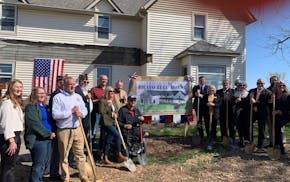ROCHESTER – With a multibillion-dollar Mayo Clinic expansion underway, officials here aim to launch a massive planning effort this year to figure out how the city will look decades from now.
Mayor Kim Norton outlined a citywide campaign Wednesday morning during her annual State of the City address to get residents involved in deciding how the city grows over the next 20 to 25 years.
A planning committee will form sometime in the spring to start meeting with residents across the city and pooling ideas on how to improve Rochester. Those ideas will go before local officials, nonprofits and businesses to act on — ensuring more people than just government staff will decide whether those ideas happen.
"Start thinking about the future you want to leave your children and grandchildren," Norton said.
The planning effort stems from Mayo Clinic's transformative $5 billion expansion over the next few years as the medical system takes over much of the skyline in the downtown area.
Mayo officials plan to start building demolition later this year to make way for parking lots and work sites, but local officials are focused on the effects Mayo's growth will bring.
A 2020 housing study showed Rochester would need about 14,000 housing units across the city to accommodate expected growth by the end of the decade, but that was before Mayo's expansion and thousands more who will likely move here. And housing developments have struggled to keep pace with community needs in recent years.
Olmsted County officials hope to boost housing in the area through incentivizing the private market and projects with the city and area nonprofits.
"We need to have a place in our community where everyone can find a home that they can afford," Olmsted County Board Chair Sheila Kiscaden said.
The city and county could also use more publicly owned land for affordable housing, according to Norton.
City officials are looking to expand sustainable energy in downtown through a geothermal project connecting city and county offices to the Rochester Public Library and Mayo Civic Center, heating and cooling those buildings for less cost and with less environmental impact.
The project was initially trimmed down last year after the city failed to secure state bonding funding, but Rochester officials secured federal dollars through the Inflation Reduction Act to pay for the geothermal network. Now, area businesses and other organizations are looking to connect to the system, "demonstrating public support for sustainable practices," Norton said.
Norton hopes to expand on the city's sustainability and health practices in 2024, including improving the city's air quality and community food and nutrition projects. She also pointed out the need for more resources to address homelessness in the area, from a new housing shelter to more funding for public services.
"Allowing encampments is not the proper response to housing our homeless," she said.
The city also plans on starting several projects related to the $205 million sales tax extension voters approved last November. That includes money for street reconstruction, water quality, housing developments and a regional sports complex city officials say will help address recreation needs in the community, such as pickleball and indoor swimming.
Rochester City Council President Brooke Carlson said the sports complex plans will likely take shape later this year.
"We are in one of the most exciting and important moments in the history of our city," she said.
Protesters briefly clash at dual pro-Israel, pro-Palestinian rallies at the University of Minnesota

Defense attorneys in Feeding Our Future trial cast doubt on FBI's meal fraud investigation

Overdose deaths spike after incarceration, but Minnesota jails lack treatment

